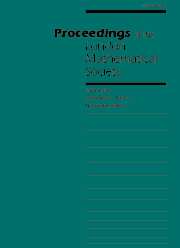Crossref Citations
This article has been cited by the following publications. This list is generated based on data provided by
Crossref.
Liu, Chuangye
Wang, Zhengping
and
Zhou, Huan-Song
2008.
Asymptotically linear Schrödinger equation with potential vanishing at infinity.
Journal of Differential Equations,
Vol. 245,
Issue. 1,
p.
201.
LIU, XIANGQING
and
HUANG, YISHENG
2009.
SIGN-CHANGING SOLUTIONS FOR A CLASS OF NONLINEAR SCHRÖDINGER EQUATIONS.
Bulletin of the Australian Mathematical Society,
Vol. 80,
Issue. 2,
p.
294.
Liu, Jiaquan
Liu, Xiangqing
and
Guo, Yuxia
2011.
On an asymptotically -linear -Laplacian equation in.
Nonlinear Analysis: Theory, Methods & Applications,
Vol. 74,
Issue. 2,
p.
676.
Genoud, François
2011.
Bifurcation from infinity for an asymptotically linear problem on the half-line.
Nonlinear Analysis: Theory, Methods & Applications,
Vol. 74,
Issue. 13,
p.
4533.
Liu, Xiangqing
and
Liu, Jiaquan
2011.
On a boundary value problem in the half-space.
Journal of Differential Equations,
Vol. 250,
Issue. 4,
p.
2099.
Guo, Yuxia
and
Liu, Xiangqing
2012.
A multiple critical points theorem and applications to quasilinear boundary value problems in.
Nonlinear Analysis: Theory, Methods & Applications,
Vol. 75,
Issue. 9,
p.
3787.
Jiangchao, Wang
and
Yimin, Zhang
2012.
A biharmonic eigenvalue problem and ITS application.
Acta Mathematica Scientia,
Vol. 32,
Issue. 3,
p.
1213.
Stuart, C.A.
2012.
Asymptotic linearity and Hadamard differentiability.
Nonlinear Analysis: Theory, Methods & Applications,
Vol. 75,
Issue. 12,
p.
4699.
Genoud, François
2013.
Global bifurcation for asymptotically linear Schrödinger equations.
Nonlinear Differential Equations and Applications NoDEA,
Vol. 20,
Issue. 1,
p.
23.
LIU, XIANGQING
and
GUO, YUXIA
2013.
SIGN-CHANGING SOLUTIONS FOR AN ASYMPTOTICALLY p-LINEAR p-LAPLACIAN EQUATION IN ℝN.
Communications in Contemporary Mathematics,
Vol. 15,
Issue. 01,
p.
1250046.
Genoud, François
2013.
Orbitally stable standing waves for the asymptotically linear one-dimensional NLS.
Evolution Equations & Control Theory,
Vol. 2,
Issue. 1,
p.
81.
Bartsch, Thomas
and
Parnet, Mona
2014.
Nonlinear Schrödinger equations near an infinite well potential.
Calculus of Variations and Partial Differential Equations,
Vol. 51,
Issue. 1-2,
p.
363.
Sun, Juntao
and
Wu, Tsung-fang
2014.
Ground state solutions for an indefinite Kirchhoff type problem with steep potential well.
Journal of Differential Equations,
Vol. 256,
Issue. 4,
p.
1771.
Stuart, C.A.
2015.
Asymptotic bifurcation and second order elliptic equations on \( R^{N} \).
Annales de l'Institut Henri Poincaré C, Analyse non linéaire,
Vol. 32,
Issue. 6,
p.
1259.
Du, Miao
Tian, Lixin
Wang, Jun
and
Zhang, Fubao
2016.
Existence and asymptotic behavior of solutions for nonlinear Schrödinger-Poisson systems with steep potential well.
Journal of Mathematical Physics,
Vol. 57,
Issue. 3,
Du, Miao
Tian, Lixin
Wang, Jun
and
Zhang, Fubao
2016.
Existence of ground state solutions for a super-biquadratic Kirchhoff-type equation with steep potential well.
Applicable Analysis,
Vol. 95,
Issue. 3,
p.
627.
Alves, Claudianor O.
Nóbrega, Alânnio B.
and
Yang, Minbo
2016.
Multi-bump solutions for Choquard equation with deepening potential well.
Calculus of Variations and Partial Differential Equations,
Vol. 55,
Issue. 3,
Bartolo, Rossella
Candela, Anna Maria
and
Salvatore, Addolorata
2016.
Multiplicity results for a class of asymptotically p-linear equations on ℝN.
Communications in Contemporary Mathematics,
Vol. 18,
Issue. 01,
p.
1550031.
Wu, Yuanze
Wu, Tsung-fang
and
Zou, Wenming
2017.
On a two-component Bose–Einstein condensate with steep potential wells.
Annali di Matematica Pura ed Applicata (1923 -),
Vol. 196,
Issue. 5,
p.
1695.
Jia, Huifang
and
Luo, Xiao
2018.
Existence and concentrating behavior of solutions for Kirchhoff type equations with steep potential well.
Journal of Mathematical Analysis and Applications,
Vol. 467,
Issue. 2,
p.
893.


